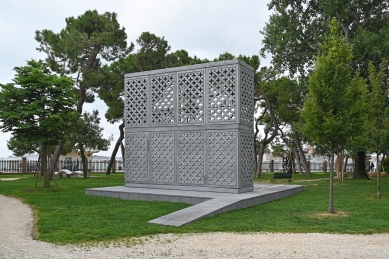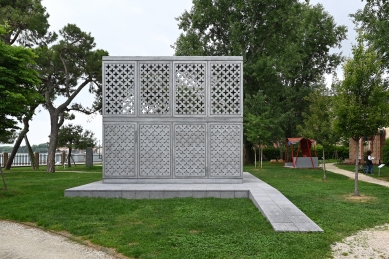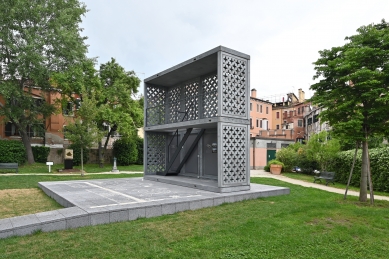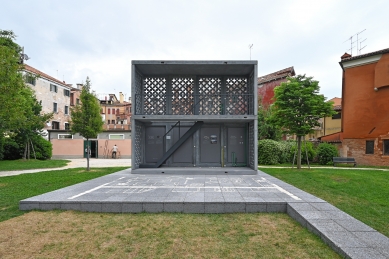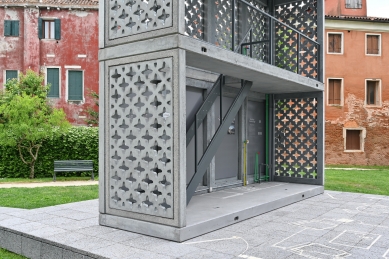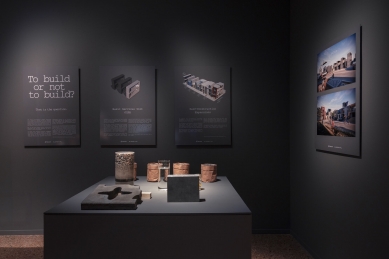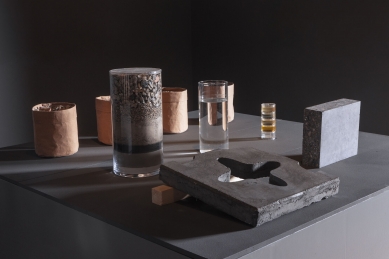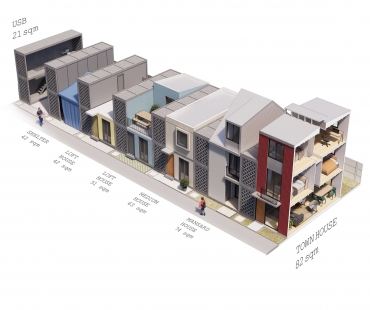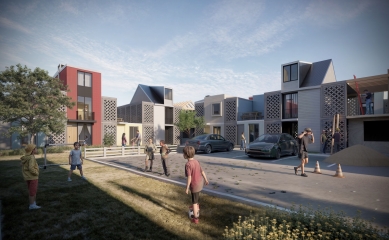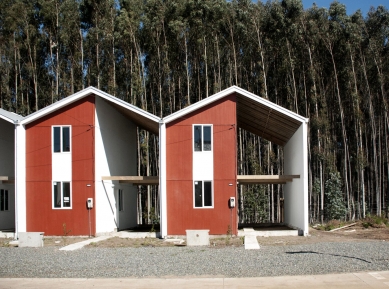
Growing housing
Prototype of the basic residential core (USB)

Prototype of dynamically growing housing that uses bioconcrete BioChar to reduce carbon emissions.
The architectural studio Elemental, led by Pritzker Prize winner Alejandro Aravena, has teamed up with building materials manufacturer Holcim to jointly present a project at the 19th Venice Architecture Biennale: a prototype of a basic living core (USB) with zero consumption of new materials, which Aravena described as the "most radical" design of his studio so far. The project is built upon more than twenty years of research by Elemental in the field of incremental housing and Holcim's expertise in sustainable construction and materials.
In incremental housing, Elemental first constructs the technically complex and costly parts of the house - the load-bearing structure, roof, kitchen, bathroom, and basic engineering networks - while leaving ample space around for the house to expand over time. This approach allows families to safely and gradually complete their homes, creating fully functional residences with increasing value. Over the last two decades, Elemental has implemented this model in over a thousand examples across Latin America.
Elemental and Holcim took this concept a step further in Venice, presenting a compact structure that meets the most essential needs. The prototype - named "construction sanitary unit," which is showcased as part of the Time Space Existence exhibition - occupies an area of 21 square meters over two floors and includes all the necessary infrastructure for a kitchen and bathroom. The object is built from concrete prefabricated panels that facilitate quick assembly. The panels contain openings that reduce weight and improve ventilation, making the structure suitable for tropical climates, where several projects of incremental housing have already been realized.
The living units are designed to meet basic needs - shelter and hygiene - while also offering residents the possibility for future expansion. A painted floor plan on the pavement next to the living unit illustrates potential expansion. As Alejandro Aravena from Elemental notes: "Incremental design takes into account the fact that 'housing' is a process, not a product; it's more about a living process than a static affair."
Innovation extends beyond the project boundaries: this is the first use of concrete from Holcim that can bind carbon. This concrete mix contains BioChar, a carbon-rich material made from organic waste. Every kilogram of BioChar used can prevent the release of up to three kilograms of CO₂ into the atmosphere, effectively turning the building into a carbon sink. Additionally, the concrete contains 100% recycled aggregate, further contributing to the sustainability of the entire structure.
The prototype of the basic living core USB presented at the architecture biennale in Venice exemplifies how innovative projects and sustainable materials can address urgent housing needs while mitigating environmental impact. By utilizing bioconcrete and a modular principle, the project offers an easily expandable solution for carbon-neutral living.
The architectural studio Elemental, led by Pritzker Prize winner Alejandro Aravena, has teamed up with building materials manufacturer Holcim to jointly present a project at the 19th Venice Architecture Biennale: a prototype of a basic living core (USB) with zero consumption of new materials, which Aravena described as the "most radical" design of his studio so far. The project is built upon more than twenty years of research by Elemental in the field of incremental housing and Holcim's expertise in sustainable construction and materials.
In incremental housing, Elemental first constructs the technically complex and costly parts of the house - the load-bearing structure, roof, kitchen, bathroom, and basic engineering networks - while leaving ample space around for the house to expand over time. This approach allows families to safely and gradually complete their homes, creating fully functional residences with increasing value. Over the last two decades, Elemental has implemented this model in over a thousand examples across Latin America.
Elemental and Holcim took this concept a step further in Venice, presenting a compact structure that meets the most essential needs. The prototype - named "construction sanitary unit," which is showcased as part of the Time Space Existence exhibition - occupies an area of 21 square meters over two floors and includes all the necessary infrastructure for a kitchen and bathroom. The object is built from concrete prefabricated panels that facilitate quick assembly. The panels contain openings that reduce weight and improve ventilation, making the structure suitable for tropical climates, where several projects of incremental housing have already been realized.
The living units are designed to meet basic needs - shelter and hygiene - while also offering residents the possibility for future expansion. A painted floor plan on the pavement next to the living unit illustrates potential expansion. As Alejandro Aravena from Elemental notes: "Incremental design takes into account the fact that 'housing' is a process, not a product; it's more about a living process than a static affair."
Innovation extends beyond the project boundaries: this is the first use of concrete from Holcim that can bind carbon. This concrete mix contains BioChar, a carbon-rich material made from organic waste. Every kilogram of BioChar used can prevent the release of up to three kilograms of CO₂ into the atmosphere, effectively turning the building into a carbon sink. Additionally, the concrete contains 100% recycled aggregate, further contributing to the sustainability of the entire structure.
The prototype of the basic living core USB presented at the architecture biennale in Venice exemplifies how innovative projects and sustainable materials can address urgent housing needs while mitigating environmental impact. By utilizing bioconcrete and a modular principle, the project offers an easily expandable solution for carbon-neutral living.
The English translation is powered by AI tool. Switch to Czech to view the original text source.
0 comments
add comment


